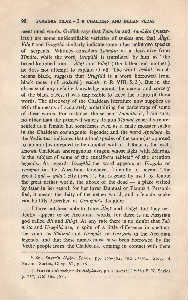Page 738 - Lokmanya Tilak Samagra (khand 2)
P. 738
90, SAMAGRA TILAK - 2 • CHALDE,AN AND INDIAN VEDAS
mentioned words. Griffith says that Taimata and Apodaka (water-
less ) are some unidentifiable varieties of snakes and that Alig£,
Vilig£ and Urugu/a similarly indicate some other unknown species
of serpents. Whitney considers Taimata as a derivative from
Timata, while the word UrugUla is translated by him as ' the
broad-knobbed one'. Alig£ and Vilig£ (the father and mother)
he does not attempt to explain at all. The word asiknt, which
means black, suggests that Urugula is a word borrowed from
black races ( cf. asiknt!z ) visha!z in R VIII, 5. 3 ). But in the
absence of any definite knowledge about the magic and sorcery
of the black races, it was impossible to trace the .origin pf these
words. The discovery of the Chaldean literature now supplies us
with the means of accurately ascertaining the parcentage of some
of these words. For instance, the serpent Taimata is, I am sure,
no other than the primeval watery dragon Tidmat generally repre-
sented as a female but sometimes even as a male monster snake
in the Chaldean cosmo gonic legends; and the word Apodaka in
the Vedic text indicates that a land species of the same (as opposed
to aquatic ) is intended to be coupled with it. Tiamat is the well-.
known Chaldean androgynous dragon whose fight with Marduk
is the subject of some of the cuneiform tablets • of the creation
legends. As regards Uruguld the word appears as Urugala or
Urugu/a in the Accadian language. Literally, it means 'the
great (gal = gula) city ( uru) ', but is generally used to denote
the great nether world, the abode of the dead - a place visited
by Istar in her search for her lover Dumuzi or Tamuz. t Personi-
fied, it means the deity of the nether world, and a female snake
can be fitly described as Uru-gula's daughter.
I have not been able to trace Alig£ and Vilig£, but they evi-
dently appear to be Accadian words, for there is an Assyrian
god called Bil and Bil-gi. At any rate there is no doubt that Tai-
mata and Urugula are, in spite of a little difference in spelling,
the same as Tiamat and Urugala or Uru-gula in the Accadian
legends, and that these names must have been borrowed by the
Vedic people from the Chaldeans, coming in contact with them
• See Sayee's Hibbert Lectures pp. 379-384, and Clwldea, Story of
Nations Series, Chap. VI, p. I 6.
t Jensen's Kosmu!ogie der Bahyl()ltier, pp. z I 7-222; Chalden S. N. Series
p. r 57, 326f and 367f.

